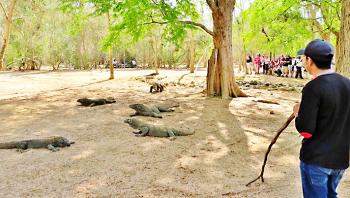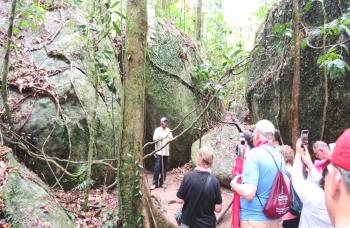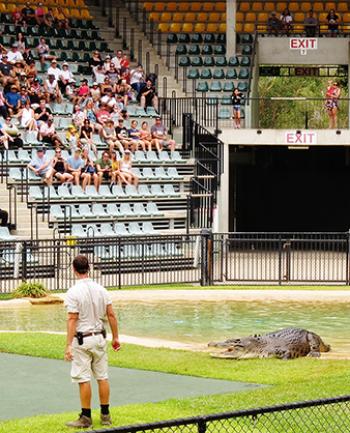From Bali to Sydney with Viking
This item appears on page 21 of the October 2021 issue.
We sailed on the Bali-to-Sydney “Komodo & the Australian Coast” cruise aboard the Viking Orion of Viking Ocean Cruises (Los Angeles, CA; 855/338-4546, www.viking.com), Dec. 9-27, 2019.
Our Deluxe Veranda Stateroom cost us $4,999 each. The fare included air (Tucson-Los Angeles-Hong Kong-Denpasar), but we used frequent-flyer miles to upgrade to business class. Trip insurance cost an additional $619 apiece. We took a shore excursion at every port stop — some tours included in the fare, some costing extra, all of them interesting and well worth the time.
From Bali, the ship went straight to the island of Lombok for our first excursion. In the pottery-making village of Banyumulek, we watched women pinch pieces of clay into small bowls, then turn them on “pottery wheels” with their toes.
Although interesting, this village somehow turned us off, probably because of the heat and humidity, the piles of rubbish, the ubiquitous smell of garbage and the persistent vendors trying to sell us fabrics, jewelry and trinkets.
Another excursion in Indonesia was to the Meninting arts-and-crafts market, which was cleaner, well organized and had well-made goods. There were carved and painted wooden engravings and figurines and tightly woven baskets.
Outside the market, men staged a performance. Flutists and drummers played frantic-sounding music as two teenage boys with sticks and woven wooden shields jumped around and whacked at each other until one of them fell down. It appeared to us to be more of a competition than a dance.
Komodo island, our next cruise stop, was a trip highlight. We had expected to follow trails, searching for Komodo dragons. However, Komodo National Park employees had enticed several dragons into an area near an artificial watering hole.
A line drawn in the sand in a large circle around the dragons separated them from the tour groups. People stood outside the circle, while the dragons were supposed to stay inside it. Men armed with long forked sticks kept watch over the dragons, which appeared lethargic and sleepy. One large dragon waddled from the forest through our tour group to join other dragons in the circle.
Along a forest path, we saw small Timor deer, which comprise 40% of the dragons’ diet.
The ship then took us across the Timor Sea to Darwin, where we learned about Australia’s extensive involvement in World War II. Australian troops initially fought in Europe and North Africa, but most returned to Australia and the South Pacific after the Japanese bombed Darwin in 1942, killing over 200 people.
At the very interesting Darwin Military Museum, we saw the film “The Battle for Australia,” about the city’s role in the war, and walked around to see military vehicles and equipment that had been used by Australian and US forces stationed there.
Also in Darwin, we visited Crocodylus Park (www.crocodyluspark.com.au), where crocodiles are raised for their skins and meat. This is the home of the famous “jumping” crocodiles, and we watched as they jumped half their body length out of the water to catch pieces of meat tossed to them.
The Viking Orion next crossed the shallow Arafura Sea and Torres Strait to Thursday Island. During the last Ice Age, this area was a land bridge over which people could migrate between New Guinea and Australia.
We toured Green Hill Fort, which was used as a signals and wireless station and ammunition store during WWII. Although military targets on nearby Horn Island were bombed, Thursday Island was never bombed because the Japanese apparently believed that a community of Japanese people, who worked in the pearling industry, lived there, but they had actually been evacuated to the mainland early in the war.
The ship then turned south into the Coral Sea, where invited lecturers gave interesting and informative daily talks concerning WWII battles and ships. The onboard reef pilot gave fascinating lectures about navigating among the shallow reefs and islands around Australia.
At Cairns, we took a shore tour north to Mossman Gorge in Daintree National Park, in the Wet Tropics of Queensland. Daintree is the largest tropical rainforest in Australia and the oldest in the world. From the tour bus, we had beautiful views of the bright blue Coral Sea.
Mossman Gorge is managed by the Kuku Yalanji people, who have lived in the area for over 50,000 years. They offer tours through the gorge and operate a very nice cafeteria and gift shop.
The “Dreamtime” tour was a trip highlight. Hiking through the thick forest with overhanging vines and branches, we could imagine that we were in Jurassic Park. Aboriginal guide Tom showed us how, years ago, his people made soap from bark, ground minerals for body paint and communicated by pounding on hollow trees. At the end of the tour, he served us “billy tea and damper” (tea brewed over a campfire plus scones with butter and jam).
Townsville was our next port. At the Museum of Tropical Queensland, we learned about the natural history and archaeology of the area. Moving next door to ReefHQ (the Great Barrier Reef aquarium), we visited the museum’s tropical sea turtle hospital and saw how they rehabilitate sick and malnourished sea turtles. In the aquarium itself, we saw myriad multicolored tropical fish swim close to us behind floor-to-ceiling glass walls.
The ship continued south to Airlie Beach, then traveled to the town of Proserpine. Staff at the Proserpine Historical Museum offered homemade Anzac biscuits (oatmeal cookies with dried coconut and locally produced sugar) to nibble on as we wandered through the exhibits.
At an environmentally accredited sugarcane farm, we learned how correctly measuring the amount of fertilizer and water needed by soils in different parts of the fields prevents excess fertilizer from running off into the ocean and damaging the Great Barrier Reef.
In Brisbane, Australia Zoo was another trip highlight. It is owned and managed by the Irwin family, of “Crocodile Hunter” Steve Irwin fame. The zoo is large and mostly open-air, with large animal enclosures. Visitors can enter an enclosure and pet small, tame kangaroos and have their picture taken holding a baby koala.
The daily highlight at the zoo is the show in the open-air Crocoseum stadium. Two nimble, young zoo employees with strong nerves approach within striking distance of a man-eating-size crocodile. As the crocodile lunges forward, both employees quickly jump backward as one of them tosses a whole dead chicken into its gaping mouth.
We ended our visit to Australia with a tour of Newcastle, where large numbers of people were relaxing at the beach. Tour guides told us that, in their warm climate, going to the beach and later grilling prawns on a barbecue is an Australian Christmas tradition. We saw numerous signs in store windows advertising “Christmas prawns.”
Our Viking cruise was a very pleasant way to spend a Christmas holiday season.
MARGARET & ROGER HINKLE
Oro Valley, AZ



